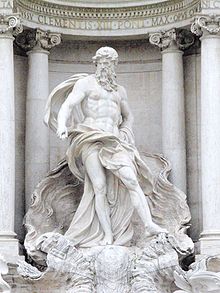Oceanus
| Oceanus | |
|---|---|
| Titan god of the sea | |

Oceanus in the Trevi Fountain, Rome
|
|
| Abode | Arcadia |
| Consort | Tethys |
| Parents | Uranus and Gaia |
| Siblings |
|
| Children | Thetis, Metis, Amphitrite, Dione, Pleione, Nede, Nephele, Amphiro, and the other Oceanids, Inachus, Amnisos and the other Potamoi |
| Roman equivalent | Oceanus |
Oceanus (/oʊˈsiːənəs/; Greek: Ōkeanós,pronounced [ɔːkeanós]), also known as Ogenus (Ogenos, Ωγηνος) or Ogen (Ωγην), was a divine figure in classical antiquity, believed by the ancient Greeks and Romans to be the divine personification of the sea, an enormous river encircling the world.
Strictly speaking, Oceanus was the ocean-stream at the Equator in which floated the habitable hemisphere (οἰκουμένη, oikoumene). Thus, the sun rises from the deep-flowing Oceanus in the east and at the end of the day sinks back into the Oceanus in the west. In Greek mythology, this world-ocean was personified as a Titan, the eldest son of Uranus and Gaia. In Hellenistic and Roman mosaics, this Titan was often depicted as having the upper body of a muscular man with a long beard and horns (often represented as the claws of a crab) and the lower body of a serpent (cf. Typhon). On a fragmentary archaic vessel of circa 580 BC (British Museum 1971.11-1.1), among the gods arriving at the wedding of Peleus and the sea-nymph Thetis, is a fish-tailed Oceanus, with a fish in one hand and a serpent in the other, gifts of bounty and prophecy. In Roman mosaics, such as that from Bardo he might carry a steering-oar and cradle a ship.
...
Wikipedia
